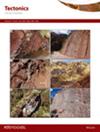Is the Inverted Field Gradient in the Catalina Schist Terrane Primary or Constructional?
IF 3.6
1区 地球科学
Q1 GEOCHEMISTRY & GEOPHYSICS
引用次数: 0
Abstract
New geothermometry using laser-Raman data on carbonaceous material from low and intermediate grade rocks on Santa Catalina Island, California, together with existing thermobarometric data, show that there is a quasi-continuous increase in peak metamorphic temperature from 327 ± 8°C in lawsonite blueschist facies rocks at the lowest structural levels, through ∼433°C in overlying epidote blueschists, 546 ± 20°C in albite-epidote amphibolite facies rocks, to 650–730°C in amphibolite facies rocks at the top of the sequence. Rocks of different metamorphic grade are separated from one another by tectonic contacts across which temperature increases by ∼100°C in each case. Previously published geochronological data indicate that peak metamorphism in the highest grade rocks at 115 Ma preceded deposition of blueschist facies metasediments by ∼15 million years, so that the present inverted grade sequence does not represent an original inverted temperature gradient. The present structure results from progressive underplating of oceanic rocks in a cooling subduction zone following a high-T metamorphic event at 115 Ma. An inverted temperature gradient of ≥100°C/km across the subduction channel likely existed during the high-T event, decreased during underplating, and reached zero by ∼90 Ma.卡塔利娜片岩地层中的倒磁场梯度是原生的还是构造的?
利用激光拉曼对加利福尼亚州圣卡塔利娜岛中低级岩石中的碳质材料进行新的地质测温,并结合现有的测温数据、显示,变质峰值温度呈准连续上升趋势,从最低构造层位的劳森蓝晶岩面岩的 327 ± 8°C,到上覆的闪长岩蓝晶岩的 433 ∼ 433°C,白云石-闪长岩面岩的 546 ± 20°C,再到层位顶端的闪长岩面岩的 650-730°C 不等。不同变质等级的岩石之间被构造接触分隔开来,温度在每种情况下都上升了 ∼ 100°C。之前公布的地质年代数据表明,最高品位岩石的变质峰值出现在115Ma,比蓝晶岩变质岩沉积的时间早1500万年,因此目前的倒转品位序列并不代表原始的倒转温度梯度。目前的构造是在115Ma的高T变质事件之后,冷却俯冲带中的大洋岩石逐渐下沉的结果。整个俯冲通道上≥100°C/km的倒转温度梯度很可能在高T事件期间就已存在,在下沉过程中温度梯度下降,到90Ma时温度梯度为零。
本文章由计算机程序翻译,如有差异,请以英文原文为准。
求助全文
约1分钟内获得全文
求助全文
来源期刊

Tectonics
地学-地球化学与地球物理
CiteScore
7.70
自引率
9.50%
发文量
151
审稿时长
3 months
期刊介绍:
Tectonics (TECT) presents original scientific contributions that describe and explain the evolution, structure, and deformation of Earth¹s lithosphere. Contributions are welcome from any relevant area of research, including field, laboratory, petrological, geochemical, geochronological, geophysical, remote-sensing, and modeling studies. Multidisciplinary studies are particularly encouraged. Tectonics welcomes studies across the range of geologic time.
 求助内容:
求助内容: 应助结果提醒方式:
应助结果提醒方式:


